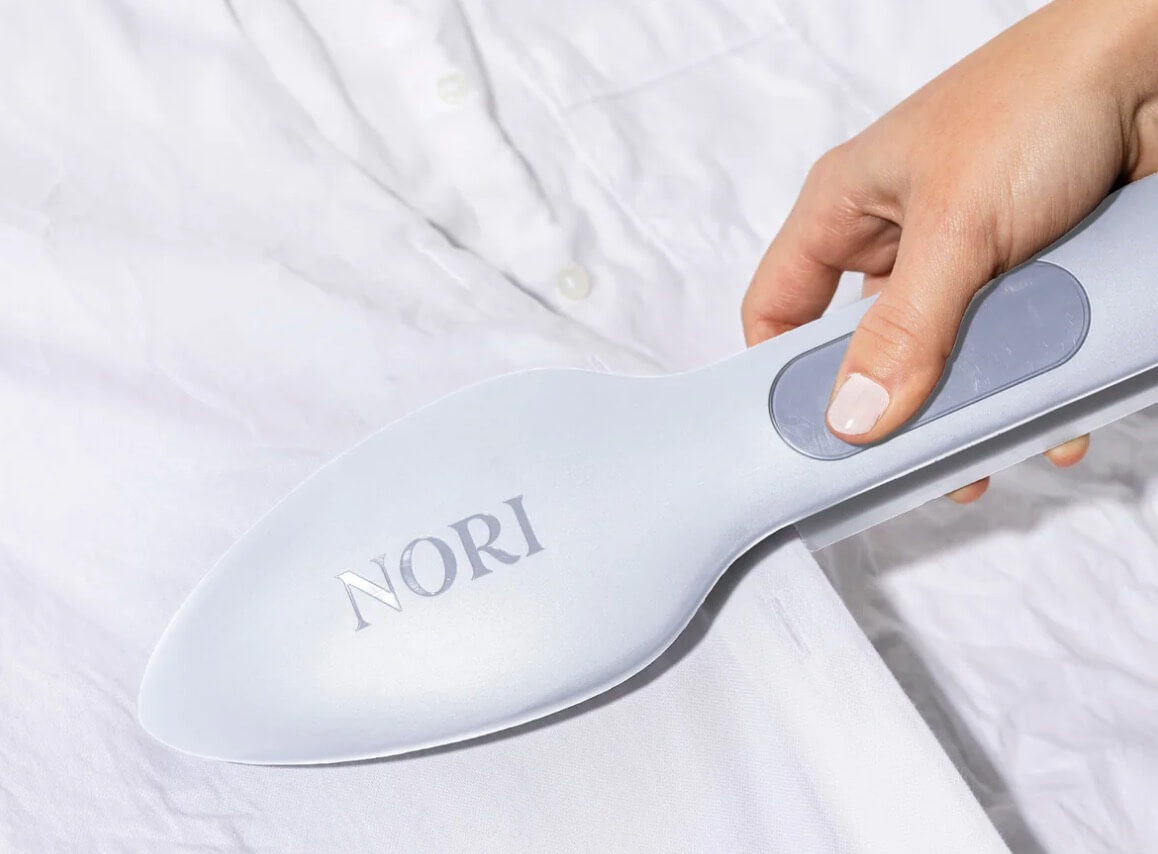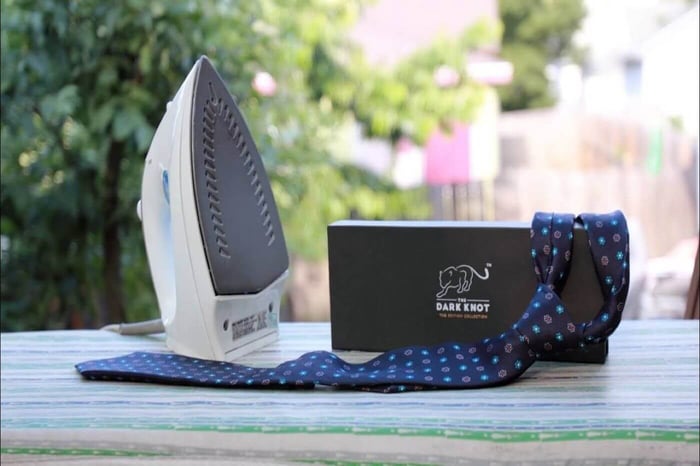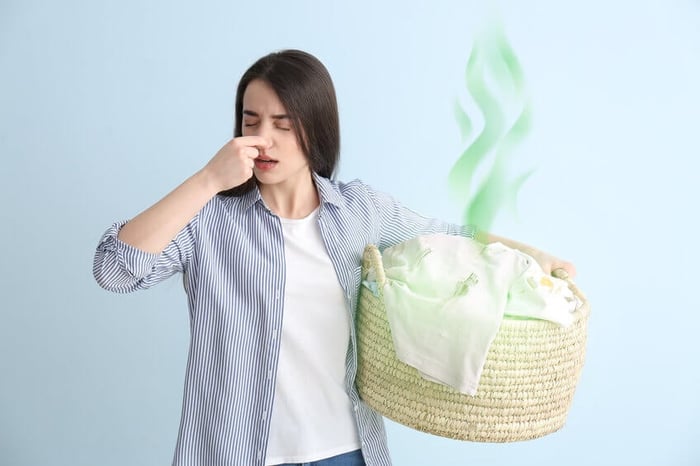
Wondering how to get mothball smell out of clothes? There is nothing more frustrating than a closet with the smell of mothballs permeating through your clothing. Once you have been in your house for a while, that natural mothball odor can start to linger on your clothes. Clothing mothballs are effective in deterring moths and other insects, but they leave a persistent and unpleasant odor that is hard to get rid of and can be really tough on clothing too!
In this blog post, we'll talk about everything you need to know about mothballs and how to get mothball smell out of clothes. This includes using steam irons, such as the Nori Press, to help get rid of the mothball smell. Learn more about what Nori Press can do here.
What is a Mothball?
A mothball is a crystallized chemical, which has the capability of releasing a noticeable odor when warmed. When dry, they are not very harmful to humans or animals, but when wet or heated, the chemicals can be hazardous. There are two main types of mothballs—Naphthalene balls and camphor balls.
Naphthalene balls are made with naphthalene crystals that are melted together before being molded into a ball. A lot of people will let these balls air out before use for this reason. They work best at repelling woolen moths and carpet beetles.
Camphor balls are made with camphor crystals that are melted together before being molded into a ball. These balls tend to have a moth ball-type smell. They can be extremely toxic in large amounts and are not safe for use around small children or animals.
What Are Mothballs Used For?

Mothballs were originally used as insecticides. The idea was to trap insects by placing them inside a container filled with the substance. This method worked well because the fumes would kill any bugs trapped within. However, over time, scientists realized that there were other benefits to using mothballs.
The most common benefit of mothballs today is keeping clothes smelling fresh longer. If you keep your winter coat stored away in a box full of mothballs, then you won't need to worry about it getting moth eaten. It also helps prevent mildew growth on fabrics.
Another way mothballs help extend the life of your clothes is by preventing wrinkles. Since mothballs contain camphor oil, they act as a dehumidifier. As long as your clothes aren't damp, they should stay wrinkle-free.
If you don't care about extending the lifespan of your clothes, then mothballs may still be useful for another purpose: removing odors. Many people find that mothballs remove smells better than fabric softener sheets.
I personally love the scent of mothballs and enjoy wearing the scent. But since I am allergic to them, I always make sure to wear gloves whenever I handle them.
The Mothball Smell
Both types of mothballs will leave a scent wherever they go. Luckily, the odor is usually the only effect that this leaves behind. However, there are some things you can do to combat any problems that might arise. For starters, always use caution with these balls and make sure to follow the directions on the product label exactly as they are written.
Make sure to check clothes for stains or marks before storing them away. This is especially important if you are using camphor balls since the beads could leave behind a residue that will definitely make an impression. I have found some household stain removers work well on removing this sort of mark if it does occur during storage. You can also just let the clothes air out for a day or two before packing them away.
If you have a mothball smell in your closet, I recommend using a few dryer sheets and then just putting the clothes back in the closet for a couple of weeks until that smell is gone. This process may take some time to accomplish, but eventually, the smell will fade away. You can always use a scented mothball or hangers. To make this process go a little bit faster, I always spray my clothes with Febreeze before putting them away. Additionally, using an air freshener like Febreze Small Spaces Peony & Cedar can help make the entire house smell good.
If you are storing something that cannot be sprayed with air fresheners like Febreeze or leave out for a couple of days, there are other options available. The first thing I would do is place the clothes in a large Ziploc bag and vacuum out as much of the mothball smell as possible. If you do not have a vacuum, then just leave them in your basement or garage for a little bit before taking them back into your closet. To remove the remaining odor from various surfaces in the home, consider using baking soda, vinegar, or activated charcoal.
The best thing to do would be to just avoid using mothballs all together. It is understandable that you might want to protect your clothes while they are tucked away for months, but there are some better ways to accomplish this. If the smell is not an issue, try using cedar instead of mothballs. Cedar oil has been shown in studies to be three times more effective than mothballs at keeping moths away!
It can be a lot easier to find as well.
If you have been using mothballs for quite some time, you might even want to consider getting rid of your upholstered furniture and replacing it with cedar or other natural insect-resistant woods. Soft surfaces tend to attract and hold odors. This will help keep the bugs away from your clothes as well as your other belongings! It is really just an all-around great idea to switch over to these better products, which are becoming more popular every day. Just remember that it might take a little time before you notice a difference in your clothes or home.
If you have tried everything above and the smell is still there, then I would suggest following one of the five methods listed below.
How To Get Mothball Scent Out of Clothes
Wondering how to get mothball smell out of clothes? The best way to get rid of the mothball smell is to air out all your clothes outside for several hours to several days, depending on how strong the smell is. You will want to air out all your shoes too. If you are unable to leave the items outside, put them in a box and close it up for about two weeks.
If the smell is mothball smell is strong you may want to try one of the methods outlined below.
-
Method 1 Wash the clothes with white vinegar Use a solution of white vinegar and water to get rid of mothball smells. Add one cup of white vinegar for every load you wash. Run the washing machine through two complete cycles for best results, even if your clothes are not very smelly. Use a wash cycle with detergent to freshen up clothing and remove odors. After washing, air dry the clothes to help eliminate the mothball smell.
-
Method 2 Soak the clothes in vinegar If you don’t want to wash your clothes with vinegar, you can also put them in a closed plastic bag and let them sit overnight. Vinegar’s acidity neutralizes the smell of mothballs on contact, and this method is particularly useful if the smell is only mild.
-
Method 3 Dry clean. If washing and soaking your clothes in vinegar doesn’t work, take them to the dry cleaners. They will use powerful solvents to get rid of mothball smells on your clothes.
-
Method 4 Use charcoal. If you don’t want to wash your clothes but still want to get rid of the smell, consider using activated charcoal. Place it inside a jar or sealable bag and place your clothes on top of it. It will absorb the mothball smell overnight.
-
Method 5 Enzyme cleaner. If all else fails, you can use an enzyme cleaner to get rid of mothball smells on your clothes. Spray it onto the fabric and let it sit for 30 minutes before washing as normal. You can find enzyme cleaners in most grocery stores near the laundry detergents.
Tips & Warnings
Always make sure your clothes are completely dry before storing them to prevent mold growth.
If you can still smell mothballs after washing, it’s possible that there are moth eggs present on the fabric. Throw out any items that might be contaminated with moth eggs or larvae and wash the rest of your clothes.
Wash items with mothballs separately from other clothes. Use odor-free options to preserve clothing and ensure they are free from mothball odors. Mothballs will leave a yellow stain on some fabrics, so take care where you store or hang freshly laundered clothing.
If your clothes are dry clean only, ask for non-chlorine (color-safe) solvents and make sure they are free of mothballs before dropping them off.
To prevent mothball smells in the future, remove clothes from storage one at a time and air them outside or in a garage for about an hour before bringing them indoors. If you’re using cedar balls or flakes to deter moths, throw out old ones and replace them with fresh ones every three months.
FAQs
What Causes a Mothball Smell In Your House?
Mothballs contain pyridine, which has been shown to cause cancer in animals. The U.S. Department of Health and Human Services recommends against using mothballs because of these risks. However, mothballs have long been used by homeowners who do not wish to purchase commercial products containing chemicals such as pyrethrum.
How to Get the Mothball Smell Out of House
The easiest way to eliminate mothball odors is to simply open windows and doors when putting away stored clothing. This allows fresh air to circulate throughout the house. Another option is to run a fan while folding clothes. Finally, try airing out the room overnight.
Why Do People Store Their Clothing With Mothballs?
Some people like the scent of mothballs and believe that mothballs keep insects away from clothing. Whatever the reason, mothballs remain popular among some consumers despite health concerns. It's what their grandparents used and it worked for them!
Is the mothball smell bad for you?
Yes! According to the Environmental Protection Agency, mothballs contain toxic substances called naphthalene and phenyl cyclohexane. These compounds are known carcinogens and mutagens. They also pose serious threats to children's developing lungs.
Why Remove the Smell of Mothballs?
You don't need to worry if you live somewhere without mothballs. But if you'd rather avoid the odor, here are two options. First, you could buy commercially available deodorizers made specifically for removing mothball scents. Second, you could create your own homemade solution. To learn how to remove mothball smells natural, read our guide below.
Can I Remove Mothball Odor Naturally?
There are several ways to remove mothball smells from clothing. One method involves soaking garments in water mixed with baking soda. Baking soda neutralizes the chemical properties of mothballs, making them less effective. It works best if you soak the item for 24 hours. Afterward, rinse thoroughly under running water. Repeat this process twice more over the course of four days.
Another alternative is to use vinegar instead of water. Vinegar contains acetic acid, which breaks down the active ingredients found in mothballs. Simply mix 1 cup white distilled vinegar with 2 cups warm water. Soak the garment in the mixture for 12 hours. Rinse well afterward. Follow this procedure twice per week for six weeks.
If you prefer to make your own cleaning solutions, consider mixing equal parts ammonia and hydrogen peroxide and liquid dish soap to form a paste. Apply the mixture directly onto stains on fabric. Let sit for 30 minutes. Then wash as usual. Always first check your clothing labels.
If you're looking for another home remedy, lemon juice will work wonders at eliminating mothball smells. Mix one part lemon juice with three parts hot water. Allow the mixture to cool before applying to stained areas. Leave the stain alone for 15 minutes. Wash as normal afterwards.
Can I Use Other Insect Deterrents Instead Of Mothballs?
There are several alternatives available to mothballs. One alternative is citronella candles. Citronella oil repels mosquitoes and ticks, making this product effective for use outdoors. For indoor protection, however, citronella candles must not be placed near bedding and furniture.
Another alternative is diatomaceous earth. Diatomaceous earth contains tiny silica crystals that kill most types of household insects. Simply sprinkle diatomaceous earth over infested surfaces and let it sit for 30 minutes. Then sweep it up and dispose of it properly.
Finally, there's boric acid powder. Boric acid kills cockroaches and other crawling insects. Sprinkle some on floors, walls, and ceilings. Let dry completely before vacuuming. Always take care if you have pets.
There are also many cedar products that will deter moths and the scent is much more pleasant and safer than mothballs.
What Causes a House to Smell Like Mothballs?
If you find that your home smells like mothballs after storing winter clothing, here are three possible reasons:
1) Your home does not get enough ventilation. If you leave windows closed during cold months, they will trap moisture inside. Moisture attracts moths, so make sure to open windows periodically.
2) There is too much humidity in your home. Humidity encourages mold growth and mildew development. Mold spores thrive in moist environments. Make sure to clean and dry any damp spots regularly.
3) The mothballs themselves have become contaminated. Some mothballs come pre-soaked with chemicals designed to deter moths. However, these chemicals eventually break down and release harmful fumes. When using mothballs, always follow instructions carefully. Never reuse old mothballs because doing so increases the risk of contamination.
Do Not Reuse Old Mothballs
Mothballs lose effectiveness as time passes. Once used, mothballs cannot be reused. This means that even though you may still see mothballs at stores, chances are they were purchased years ago. In fact, new mothballs cost less than $5 per box. So instead of buying more mothballs, buy something else.
When Should I Replace My Clothing Stored With Mothballs?
The EPA recommends replacing mothballs every six months. After two years, mothballs begin losing their ability to protect against insect damage. At that point, you'll probably notice signs of deterioration such as discoloration, cracking, and crumbling.
The best way to ensure that clothes stored with mothballs remain fresh is to rotate them frequently. Store one set of clothing in mothballs while another set remains unopened. Rotate through each group every few weeks.
Iron your clothes before wearing them as well. Garment steamers like the Nori Press can help remove the smell of mothballs from your clothing.

Learn more about the Nori Press here.
Is There Anything Else I Can Do About Mothball Smells?
Yes! Here are four tips to help keep mothballs out of your closets:
1) Keep your closet doors shut. Insects need air circulation to survive. They also prefer warm temperatures. By keeping your closet door shut, you prevent heat from escaping and allow cool air to circulate freely throughout your room.
2) Use plastic bags rather than paper ones. Paper bags tend to absorb odors, which makes them difficult to remove later. Plastic bags do not hold odors well, so they're easier to wash away.
3) Wash everything thoroughly. Washing removes dirt and grime, making it harder for pests to hide. Also, washing helps eliminate bacteria that could cause odor problems.
4) Vacuum daily. Dust collects around furniture legs and under beds. It also accumulates near vents and cracks in the flooring. These areas provide easy access points for bugs and rodents. Regularly vacuumed dust prevents this buildup.
Can I Remove Odor From Clothing Using Vinegar?
Vinegar has been known to work wonders when removing smells from fabric. Simply mix equal parts vinegar and water together and soak fabrics overnight. Rinse the next day and hang dry. Repeat if necessary.
What Other Ways Are There To Prevent Mothball Smells From Getting Into Clothes?
You should never use mothballs on bedding. Bedding needs special protection from insects due to its softness. Instead, try placing mothballs in drawers or other hard surfaces. If you must use mothballs on bed linens, make sure to treat only the top layer.
If you find yourself storing large amounts of clothing over winter, consider purchasing some type of garment bag. Garment bags are available in various sizes and styles. Many feature zippers along the sides, allowing you to easily open and close the bag without having to worry about damaging delicate garments inside.
Will Dry Cleaning Remove the Scent of Mothballs?
Dry cleaners have different methods for treating stains and odors. Some will clean clothing using steam machines like the Nori Press, and others by soaking pieces in chemicals. Dry cleaning services usually include drying the item after treatment. Learn more about the Nori Press here.
Mothballs aren't just used to ward off moths; they can also be used to preserve clothing. The key to preventing mothball scents from getting into your favorite outfits lies in rotating your clothing regularly. This ensures that any lingering mothball scent dissipates quickly.
Some Alternatives to Using Mothballs Include:
• Sprinkle dried lavender flowers onto clothing while still damp. Lavender oil contains natural insect-repellent properties.
• Cedar chips and blocks, placed in closets and chests, help keep out moisture and prevent mildew growth. Cedarwood is one of the most effective woods against mold because it absorbs humidity.
• Store clothing in airtight containers such as shoe boxes, laundry baskets, or even old suitcases. Make sure to label each container clearly with the name of the contents.
Iron Your Clothing with the Nori Press Today
Now that you know how to get the smell out of clothes, make sure to iron your clothing using the Nori Press to further remove the smell of mothballs.
The powerful steam of the Nori Press penetrates deep into the fabric, breaking down and eliminating unpleasant mothball smells while refreshing your garments. Equipped with two heated plates, the Nori Press irons both sides of your garment simultaneously, reducing ironing time significantly. With six fabric-specific heat settings and a steam setting, you can customize the treatment for any type of clothing.
Effortlessly maintain a fresh and clean wardrobe by removing wrinkles and odors with the Nori Press. Get your very own Nori Press today by clicking here.
Shop now and use the discount code "SHOP10" at checkout to save 10% on The Nori Press! Remove mothball odors today!




![How to Get Highlighter Out of Clothes [20 DIY Tips] – Nori Press](https://dropinblog.net/cdn-cgi/image/fit=scale-down,width=700/34243516/files/featured/Highlighting_report_risk_of_stain_on_clothes.jpeg)



